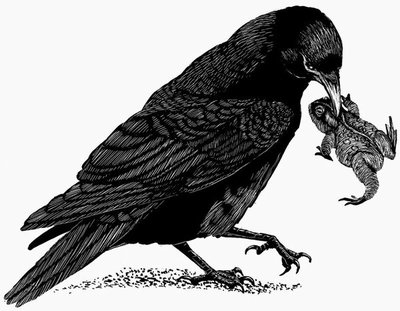January 5, 2006
Scientists ask public to help them understand crow behavior
It sounds like water — a “gloink” sound — said Elena Fox of the UW’s U-Pass office.
Just why would a crow be making such a sound, she asked John Marzluff and Tony Angell, who were speaking on campus about their book, In the Company of Crows and Ravens.
“We’re just beginning to understand their communication and calls during mobbing, what seems to be scolding and other activities,” said Marzluff, a UW professor of forest resources. One way people such as Fox can help researchers, he said, is by documenting the behavior that goes along with particular sounds.
A section of their new book, published by Yale University Press, has tips for those who’d like to help study the birds.
“In addition to detailed notes about the behaviors you observe, we encourage you to document your observations with video or still photography,” the authors write. “A picture or video is invaluable if accompanied by detailed descriptions about when, where, and how it was obtained. New digital technologies allow you to easily record and submit images to interested scientists.
“Point your cameras at vocalizing crows and ravens to catalog their rich vocal repertoires and associated postures. Try to connect a specific vocalization with a setting, context, and possible stimulus.”
The book also suggests ways to take notes that are helpful for research, to look for interested collaborators in local bird clubs and urges people to devise their own observational experiments.
Marzluff told how his daughter, when she was 8, devised an experiment where she set out French fries, one batch in a plain brown bag and the other in a bag from McDonald’s. Despite the fact they were both filled with food, the crows went to work first on the McDonald’s bag, an example of how they’ve learned which kinds of bags are most likely to offer up what they want.
“Record any use of tools. Tell how they gain access to your garbage or bird feeder,” the authors write. “Because it is so difficult to document actual cultural transmission of behaviors, pay special attention to situations where birds learn to perform adaptive tasks by watching or following each other rather than learning by trial and error. We hypothesize that this frequently occurs, but you can help test the hypothesis.”
An example involves crows in Japan along a stretch of road where imported walnut trees had been planted. Confronted with shells too hard to open on their own, one family of crows began placing the nuts under the tires of cars stopped at traffic lights. Light changes — crack go the shells.
But the practice didn’t just stay within that particular group. In 20 years it has is spread among other groups of crows more than 3 miles up and down that roadway as other groups observed and adapted the trick.
And in what the authors hypothesize as a centuries-long phenomenon of human culture interacting with crow culture, the crow’s behavior has changed the behavior of drivers who go out of their way to run over the nuts and help the crows.
“No animals interact more with us than ravens and crows,” Marzluff says. “They are found around the world with us.”
And many at the talk by co-authors Marzluff and Angell — Angell also is the illustrator of the book — had crow stories to tell.
Mary Kennedy, an Access Program student at the UW taking courses for 10 years, said she’s had crows she’s recognized coming to her yard in Revenna for 16 years. It started with just two birds. She called the larger “grandmother crow” and the smaller one with a skewed beck “nephew crow.” Other crows have taken their places over the years with there being about seven that are regulars at this time.
Julie Wharton, who lives two blocks from campus, related her observations of crows doing the “gutter walk” at her apartment. The crows appear to be watching as squirrels bury food in the debris in the roof gutters because, in no time, there they are fishing out the peanuts or whatever else the squirrels have stashed.
“Unless you live in South America or Antarctica, you probably live with some crow or raven species,” the authors write. “You and your family’s day-to-day interactions with these birds can help us all better understand our unique relationship with crows. So we invite you to challenge, probe, and test our assertions about crows and people by engaging in careful study of these amazing birds.”
To submit findings, contact Marzluff at Box 352100, University of Washington, Seattle, WA 98195.

